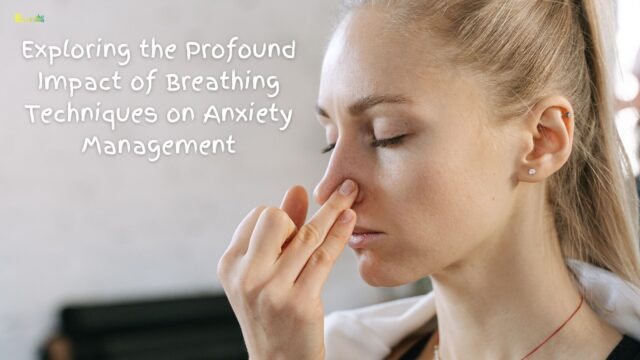Anxiety, a prevalent condition characterized by feelings of apprehension and unease, affects millions globally, often impairing daily functioning and quality of life. While anxiety is a natural response to stress, chronic manifestations can lead to a range of health issues. Fortunately, you can see the Impact of breathing techniques on anxiety management, and practical methods exist for mitigating anxiety, with breathing exercises emerging as accessible and effective tools in promoting relaxation and overall well-being.
Introduction: Unveiling the Timeless Wisdom of Breathing Techniques
Breathing techniques on anxiety management, rooted in ancient wisdom, have long been revered for their ability to alleviate tension, induce relaxation, and restore balance to the mind and body. By harnessing specific breathing patterns, these techniques offer a pathway to counteract the physiological effects of anxiety, triggering the body’s innate relaxation response and fostering a sense of calm amidst life’s challenges.
Understanding Anxiety: Delving Beyond Mental Turmoil
Anxiety transcends mere psychological discomfort, often manifesting in a myriad of physical symptoms, including muscle tension, shallow breathing, and rapid heartbeat. Chronic anxiety is intricately linked to various health conditions, underscoring the imperative of managing stress reactions and cultivating inner tranquility.
The Crucial Role of Breathing in Anxiety Alleviation: Navigating the Path to Inner Peace
Regulating breathing patterns serves as a cornerstone in modulating the body’s stress response, offering a tangible means of restoring equilibrium to the mind and body. By consciously engaging in controlled breathing exercises, individuals can counteract shallow and rapid breathing patterns associated with anxiety, paving the way for serenity and emotional resilience.
Exploring Effective Breathing Techniques: From Deep Breathing to Visualization
- Deep Breathing: Embarking on a journey of slow, deliberate inhalations and complete exhalations serves as a gateway to heart rate reduction and profound relaxation, grounding individuals in the present moment and fostering a sense of inner tranquility.
- Diaphragmatic Breathing: By directing breath into the diaphragm rather than the chest, practitioners activate the body’s parasympathetic nervous system, eliciting a profound sense of calm and alleviating anxiety-induced tension.
- Progressive Muscle Relaxation: Through the systematic tensing and subsequent relaxation of various muscle groups, individuals can release accumulated tension and cultivate a profound sense of bodily and mental relaxation, complementing the therapeutic effects of deep breathing exercises.
- Visualization Techniques: Harnessing the power of imagination, individuals can transport themselves to idyllic landscapes and serene environments, imbuing their breath with intention and facilitating deep relaxation and emotional release.
Integrating Breathing with Mindfulness Meditation: Cultivating Present-Moment Awareness
Mindfulness meditation, characterized by nonjudgmental awareness of the present moment, synergizes harmoniously with deep breathing, offering a holistic approach to anxiety management and emotional well-being. By anchoring attention to the breath, individuals cultivate resilience in the face of stress and foster a profound sense of inner peace.
Exploring Advanced Breathing Techniques: The 4-7-8 Technique and Beyond
- The 4-7-8 Technique: Inhaling for four seconds, holding for seven seconds, and exhaling for eight seconds serves as a potent antidote to anxiety, eliciting a profound sense of relaxation and tranquility as practitioners synchronize breath with intention.
- Box Breathing: By adopting a rhythmic pattern of inhaling, holding, exhaling, and holding breath for equal intervals, individuals can recalibrate the nervous system and restore equilibrium to mind and body, fostering a profound sense of calm amidst life’s turbulence.
- Alternate Nostril Breathing: Rooted in the ancient wisdom of yoga, this practice involves alternating breath flow between nostrils, balancing energy channels and promoting a sense of harmony and balance within the body.
Tips for Integration into Daily Life: Nurturing Consistency and Mindful Awareness
Consistent practice is essential for reaping the full benefits of breathing techniques, with individuals encouraged to carve out dedicated time for daily practice and seamlessly integrate breathing exercises into their daily routines. By cultivating mindful awareness of breath throughout the day, individuals anchor themselves in the present moment and cultivate emotional resilience in the face of life’s challenges.
Seeking Professional Guidance: Tailoring Approaches to Individual Needs
While breathing techniques on anxiety management offer invaluable tools for managing mild to moderate anxiety, individuals grappling with severe or persistent symptoms may benefit from seeking professional guidance. Counselors, therapists, and mindfulness instructors can provide personalized support and guidance, tailoring approaches to meet the unique needs of each individual.
Embracing Patience and Persistence: Nurturing Growth Through Dedicated Practice
Mastering breathing techniques is a journey that requires patience, dedication, and an open-minded approach. By embracing the learning process with curiosity and persistence, individuals empower themselves to explore a diverse array of techniques and discover the ones that resonate most deeply with their unique needs and preferences.
Conclusion: Embracing the Transformative Power of Breath
Breathing exercises serve as a potent gateway to anxiety management and emotional well-being, offering individuals a tangible means of cultivating inner peace and resilience in the face of life’s uncertainties. By integrating practices such as deep breathing, progressive muscle relaxation, and mindfulness meditation into their daily lives, individuals can embark on a journey of self-discovery and self-care, nurturing a profound sense of calm and balance amidst life’s ebbs and flows. Embrace the transformative power of breath, and unlock the boundless potential for healing and growth that lies within.









